中国瓷器英文介绍
- 格式:ppt
- 大小:1.13 MB
- 文档页数:1

简单介绍瓷器英语作文英文回答:Ceramics, also known as porcelain or china, are a type of pottery made from clay that has been fired at high temperatures. It is known for its delicate beauty, durability, and versatility. Throughout history, ceramics have been used for various purposes, including tableware, decorative objects, and architectural elements.One of the most famous types of ceramics is Chinese porcelain. It has a long history that dates back thousands of years and is highly regarded for its exquisite craftsmanship and intricate designs. Chinese porcelain is known for its translucent quality, which allows light to pass through the material, giving it a unique appearance.Another well-known type of ceramics is Japanese porcelain, which is often characterized by its minimalist and elegant designs. Japanese ceramics are highly valuedfor their simplicity and natural beauty. They often feature delicate patterns and motifs inspired by nature, such as cherry blossoms, bamboo, and landscapes.In addition to their aesthetic appeal, ceramics also have practical uses. For example, ceramic tableware, suchas plates, bowls, and cups, are commonly used in households around the world. They are valued for their heat resistance, making them suitable for serving hot food and beverages. Ceramic tiles are also commonly used in bathrooms and kitchens due to their durability and ease of cleaning.Ceramics have also played a significant role incultural traditions and rituals. For example, in Chinese culture, porcelain vases are often used to display flowers during special occasions and festivals. In Japan, tea ceremonies are conducted using ceramic tea bowls and utensils, which are carefully crafted and considered to be works of art.Overall, ceramics are a versatile and timeless art form that has been appreciated and used for centuries. Theirbeauty, durability, and practicality make them a popular choice for various purposes, from everyday use todecorative and ceremonial objects.中文回答:陶瓷,也被称为瓷器或瓷,是一种由高温烧制的粘土制成的陶器。
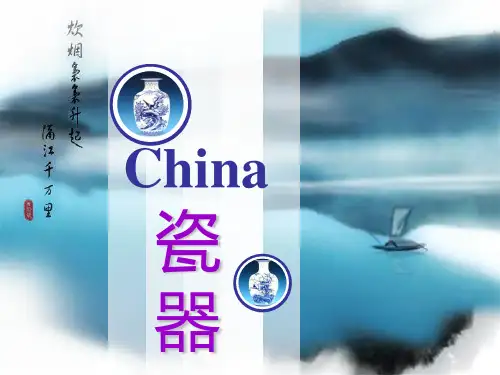
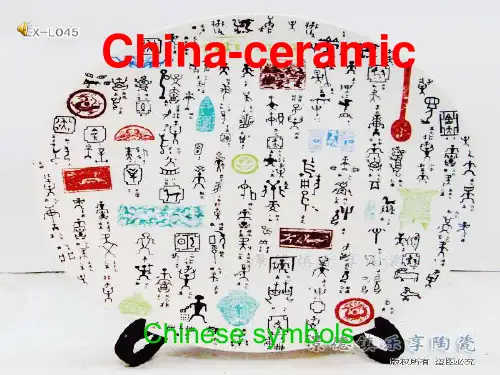
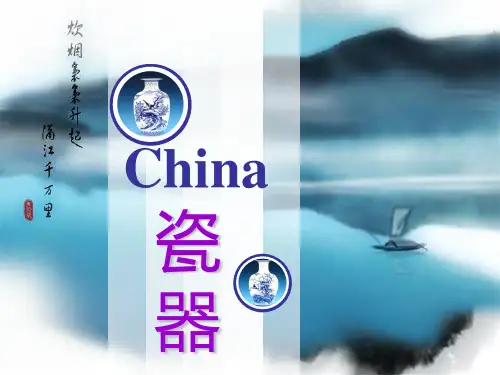
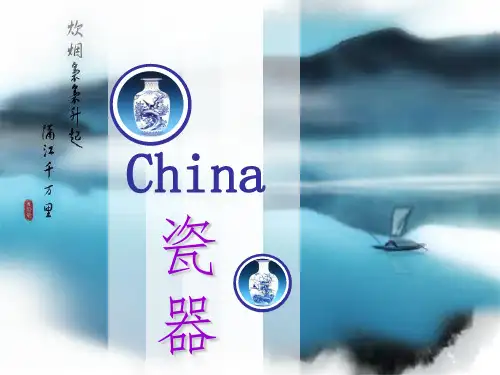

中国瓷器介绍英文版Chinese PorcelainsGood morning, everyone!Today, I want to tell you something about Chinese Porcelains. China is the hometown of porcelains. It’s an important creation of the working people of Han nationality. Porcelain developed from Pottery. The earliest porcelain appeared in Shang and Zhou dynasty about3,000 years ago. The true meaning of the Chinese porcelains produced in the Eastern Han Dynasty.In The Middle Ages, accompanied by Chinese Porcelains export, Chinese began to known in the world as “Country of Porcelain”. By the Song Dynasty some seven centuries later, the porcelain industry was flourishing. Ming andQing Dynasty was the heyday of Chinese Porcelains. The quantity and quality of porcelain production has reached the peak. Jingdezhen as the “Porcelain Capital” status has been established.Welcome to Jingdezhen Museum. Jingdezhen is located in northeastern Jiangxi. Jingdezhen porcelain is the pearl in the treasure house of Chinese art and culture. In its long and glorious history, a brilliant art and craft has been handed down. The feature of Jingdezhen Porcelain was described as being “as white as jade, as thin as paper, as bright as a mirror, with a sound as clear as a bell.” The four traditional porcelains are Blue and white porcelain,Glowing porcelain, Color glaze porcelain, and Famille-rose porcelain.Blue and white porcelain has a white base with blue designs. Blue designs are applied to the white body of the porcelain, making it appear elegant, fresh and full of vigor. Its unique artistic connotation is the perfect combined of traditional and modern arts.Glowing porcelain is also called “Mitong” in China. Craftsmen carve out many regular “delicate eyes” in the porcelain body, and then fire these holes with the glaze into the bright hole. European called it as “the transparent rice pattern”.Jingdezhen’s colorful glaze is famous for all over the world. It contains a long tradition, and is gradually concluded by our ancestors during the long-time producing and experimenting. Our ancestors had accumulated rich experience in the long time producing and struggling.Famile-rose porcelain also called soft decorative porcelain, which is one of the four traditional porcelain of Jingdezhen. As known as soft colors, is over glaze decoration of porcelain wares. “A manwithout porcelain is not noble. A room withoutporcelain is indecent.” Porcelain is ubiquitous in our culture.Thank you for your attention. Next, we will have a lunch in a five star hotel.彭雅玲。
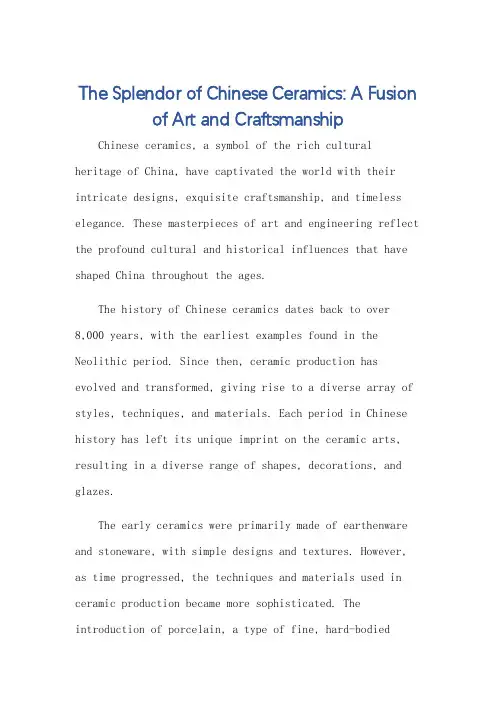
The Splendor of Chinese Ceramics: A Fusion of Art and CraftsmanshipChinese ceramics, a symbol of the rich cultural heritage of China, have captivated the world with their intricate designs, exquisite craftsmanship, and timeless elegance. These masterpieces of art and engineering reflect the profound cultural and historical influences that have shaped China throughout the ages.The history of Chinese ceramics dates back to over8,000 years, with the earliest examples found in the Neolithic period. Since then, ceramic production has evolved and transformed, giving rise to a diverse array of styles, techniques, and materials. Each period in Chinese history has left its unique imprint on the ceramic arts, resulting in a diverse range of shapes, decorations, and glazes.The early ceramics were primarily made of earthenware and stoneware, with simple designs and textures. However, as time progressed, the techniques and materials used in ceramic production became more sophisticated. The introduction of porcelain, a type of fine, hard-bodiedceramic, marked a significant milestone in the history of Chinese ceramics. Porcelain, with its translucent quality and smooth surface, became a highly prized material forboth artistic and practical purposes.The art of Chinese ceramics is not just about the material and technique; it is also about the symbolism and cultural meanings embedded in each piece. Ceramics often serve as a medium for expressing social, religious, and political beliefs. They are often decorated with patterns and motifs that reflect the natural world, mythology, and folklore, thus serving as a bridge between the human and divine worlds.The most renowned centers for ceramic production in China include the Five Great Kiln Sites - the Yuyao, Ge, Xiang, Ding, and Jun kilns. Each of these kilns has its unique style and specialty, contributing to the rich diversity of Chinese ceramics. The Yuyao kiln, for instance, is known for its delicate and translucent porcelain, while the Ge kiln is renowned for its vibrant and decorative glazes.The influence of Chinese ceramics has been felt across the globe. From the Silk Road trade to the modern era, Chinese ceramics have been exported to various countries, becoming a symbol of luxury and refinement. Their influence can be seen in the ceramic traditions of other cultures, indicating their universal appeal and enduring value.In conclusion, Chinese ceramics are not just objects of art; they are a testament to the rich cultural heritage and craftsmanship of China. They are a bridge between the past and the present, connecting us to the ancient wisdom and creativity of the Chinese people. As we admire their beauty and elegance, we are reminded of the enduring power of art and culture to transcend time and space.**中国陶瓷的辉煌:艺术与工艺的融合**中国陶瓷,作为中国丰富文化遗产的象征,以其错综复杂的设计、精湛的工艺和永恒的优雅迷倒了世界。
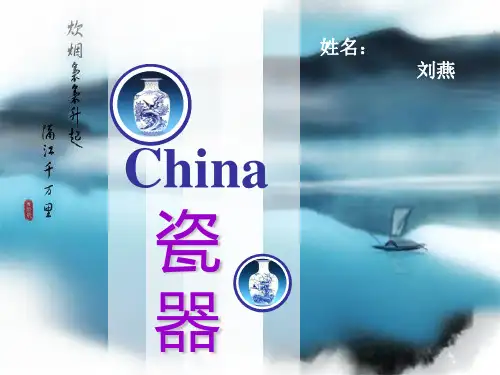
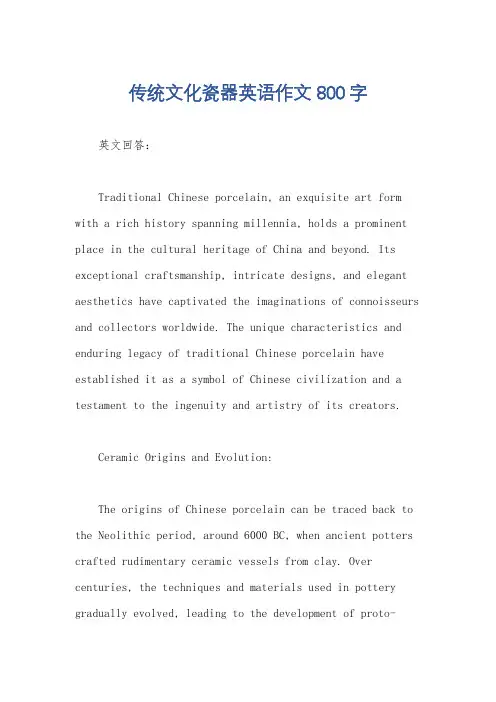
传统文化瓷器英语作文800字英文回答:Traditional Chinese porcelain, an exquisite art form with a rich history spanning millennia, holds a prominent place in the cultural heritage of China and beyond. Its exceptional craftsmanship, intricate designs, and elegant aesthetics have captivated the imaginations of connoisseurs and collectors worldwide. The unique characteristics and enduring legacy of traditional Chinese porcelain have established it as a symbol of Chinese civilization and a testament to the ingenuity and artistry of its creators.Ceramic Origins and Evolution:The origins of Chinese porcelain can be traced back to the Neolithic period, around 6000 BC, when ancient potters crafted rudimentary ceramic vessels from clay. Over centuries, the techniques and materials used in pottery gradually evolved, leading to the development of proto-porcelain during the Han Dynasty (206 BC 220 AD). Thisearly form of porcelain, characterized by its fine white body and vitreous glaze, laid the foundation for the subsequent refinement of Chinese porcelain.Tang Dynasty (618-907 AD): A Golden Age:The Tang Dynasty witnessed a golden age in the production of traditional Chinese porcelain. During this period, porcelain kilns flourished throughout the empire, and artisans reached unprecedented heights of technical proficiency and artistic creativity. The porcelains produced during the Tang era are renowned for their thin walls, pristine white glaze, and elegant shapes. The famous "Sancai" (three-color) glaze, a distinctive feature of Tang porcelain, added vibrant hues to the vessels, often depicting mythical beasts, floral motifs, and scenes from daily life.Song Dynasty (960-1279 AD): Refinement and Innovation:The Song Dynasty continued the tradition of excellencein Chinese porcelain, introducing new innovations and refining existing techniques. Song porcelains are characterized by their simple and understated elegance, with a focus on natural motifs and subtle textures. The invention of Ru, Guan, and Jun glazes, among others, brought forth a wide range of colors and effects, each with its unique aesthetic appeal. The Song Dynasty also saw the rise of celadon porcelain, with its distinctive bluish-green glaze and exquisite crackle patterns.Yuan and Ming Dynasties (1271-1644 AD): Export and Influence:During the Yuan and Ming Dynasties, traditional Chinese porcelain gained international recognition and became a highly sought-after commodity. The establishment of export-oriented kilns led to the mass production of porcelains, which were eagerly traded with countries throughout Asia, Africa, and Europe. The introduction of blue-and-white porcelain, with its cobalt oxide pigment, revolutionized the aesthetics of Chinese porcelain and had a profound influence on Western ceramics.Qing Dynasty (1644-1912 AD): Imperial Patronage and Artistic Diversification:The Qing Dynasty marked the culmination of traditional Chinese porcelain production. Under the patronage of the imperial court, porcelain kilns in Jingdezhen, the "porcelain capital of China," reached new heights of sophistication and artistry. The Kangxi, Yongzheng, and Qianlong emperors were particularly passionate about porcelain, fostering an environment of innovation and experimentation. The porcelains produced during this period are characterized by their intricate designs, rich colors, and the use of various overglaze enamels.Cultural Significance and Symbolism:Traditional Chinese porcelain has played a significant role in Chinese culture and society throughout history. It has been used for a wide range of purposes, from everyday household items to ritual objects and decorative arts. Porcelain has also been a symbol of Chinese wealth, power,and refinement, and has been used as a diplomatic gift to impress foreign dignitaries. The value placed ontraditional Chinese porcelain is evident in the numerous museums and collections dedicated to preserving and showcasing this precious art form.Conclusion:Traditional Chinese porcelain represents a fusion of science, art, and culture that has left an enduring legacy on the world. Its exquisite craftsmanship, timeless beauty, and cultural significance continue to inspire admiration and appreciation. As a testament to the ingenuity and artistic heritage of China, traditional Chinese porcelain remains a cherished and enduring treasure, connecting past and present generations through its enduring beauty.中文回答:传统文化中的瓷器。

中国瓷器介绍英文版Chinese PorcelainsGood morning, everyone!Today, I want to tell you something about Chinese Porcelains. China is the hometown of porcelains. It’s an important creation of the working people of Han nationality. Porcelain developed from Pottery. The earliest porcelain appeared in Shang and Zhou dynasty about3,000 years ago. The true meaning of the Chinese porcelains produced in the Eastern Han Dynasty.In The Middle Ages, accompanied by Chinese Porcelains export, Chinese began to known in the world as “Country of Porcelain”. By the Song Dynasty some seven centuries later, the porcelain industry was flourishing. Ming andQing Dynasty was the heyday of Chinese Porcelains. The quantity and quality of porcelain production has reached the peak. Jingdezhen as the “Porcelain Capital” status has been established.Welcome to Jingdezhen Museum. Jingdezhen is located in northeastern Jiangxi. Jingdezhen porcelain is the pearl in the treasure house of Chinese art and culture. In its long and glorious history, a brilliant art and craft has been handed down. The feature of Jingdezhen Porcelain was described as being “as white as jade, as thin as paper, as bright as a mirror, with a sound as clear as a bell.” The four traditional porcelains are Blue and white porcelain,Glowing porcelain, Color glaze porcelain, and Famille-rose porcelain.Blue and white porcelain has a white base with blue designs. Blue designs are applied to the white body of the porcelain, making it appear elegant, fresh and full of vigor. Its unique artistic connotation is the perfect combined of traditional and modern arts.Glowing porcelain is also called “Mitong” in China. Craftsmen carve out many regular “delicate eyes” in the porcelain body, and then fire these holes with the glaze into the bright hole. European called it as “the transparent rice pattern”.Jingdezhen’s colorful glaze is famous for all over the world. It contains a long tradition, and is gradually concluded by our ancestors during the long-time producing and experimenting. Our ancestors had accumulated rich experience in the long time producing and struggling.Famile-rose porcelain also called soft decorative porcelain, which is one of the four traditional porcelain of Jingdezhen. As known as soft colors, is over glaze decoration of porcelain wares. “A manwithout porcelain is not noble. A room withoutporcelain is indecent.” Porcelain is ubiquitous in our culture.Thank you for your attention. Next, we will have a lunch in a five star hotel.彭雅玲。
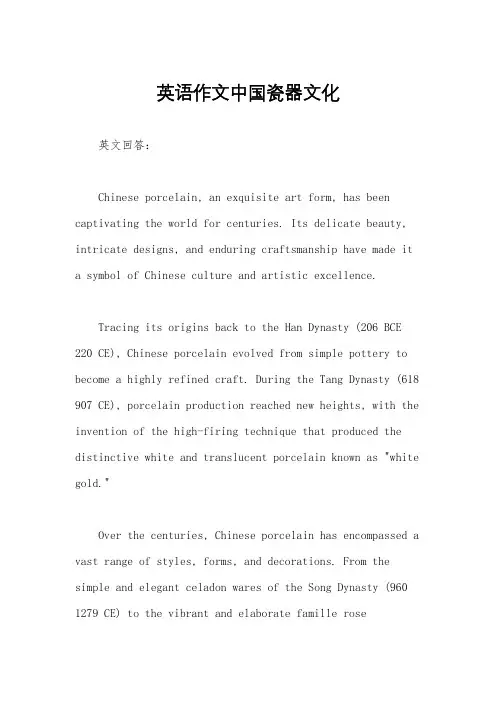
英语作文中国瓷器文化英文回答:Chinese porcelain, an exquisite art form, has been captivating the world for centuries. Its delicate beauty, intricate designs, and enduring craftsmanship have made it a symbol of Chinese culture and artistic excellence.Tracing its origins back to the Han Dynasty (206 BCE 220 CE), Chinese porcelain evolved from simple pottery to become a highly refined craft. During the Tang Dynasty (618 907 CE), porcelain production reached new heights, with the invention of the high-firing technique that produced the distinctive white and translucent porcelain known as "white gold."Over the centuries, Chinese porcelain has encompassed a vast range of styles, forms, and decorations. From the simple and elegant celadon wares of the Song Dynasty (960 1279 CE) to the vibrant and elaborate famille roseporcelains of the Qing Dynasty (1644 1912 CE), Chinese porcelain showcases the artistry and cultural heritage of China.The techniques used in the creation of Chinese porcelain are as mesmerizing as the finished products. Potters employ a combination of skilled craftsmanship, meticulous attention to detail, and the finest materials to produce each piece. The clay is carefully selected and refined, then formed into the desired shape using molds or a potter's wheel. After drying, the porcelain is glazed and fired at high temperatures in a kiln. This process requires immense skill and experience to achieve the perfect balance of heat and duration, ensuring the porcelain's durability, translucency, and glossy finish.Chinese porcelain has played a significant role in cultural exchange and diplomacy throughout history. During the Ming Dynasty (1368 1644 CE), porcelain became a highly sought-after commodity by European traders, who were amazed by its beauty and sophistication. The export of Chinese porcelain had a profound influence on Western art anddesign, inspiring European potters to emulate thetechniques and aesthetics of Chinese porcelain.Today, Chinese porcelain continues to be celebrated asa timeless art form. It is collected by museums and discerning collectors worldwide, and its presence in homes and palaces adds a touch of elegance and cultural richness. Whether it is a delicate teacup, an ornate vase, or a grand centerpiece, Chinese porcelain embodies the essence of Chinese artistry and the enduring legacy of a civilization that has forever been intertwined with the art of porcelain.中文回答:作为中国传统文化瑰宝之一,瓷器自古以来便以其出众的品质和精湛的工艺享誉中外。
瓷器英文介绍英语作文英文:Ceramics are a type of pottery made from clay that has been fired at high temperatures. They are known for their durability, beauty, and versatility. Ceramics have been used for thousands of years, from ancient Greek and Roman pottery to modern-day dinnerware and art pieces.One of the most famous types of ceramics is porcelain, which originated in China over 1,000 years ago. Porcelain is known for its pure white color, translucency, and delicate appearance. It is often used to make fine china, vases, and figurines.Ceramics can also be used for practical purposes, such as in the construction of buildings and homes. Ceramictiles are commonly used for flooring and walls, as they are durable, easy to clean, and come in a wide variety of colors and designs.In addition to their practical uses, ceramics are also valued for their artistic qualities. Many artists use ceramics as a medium for their sculptures and other worksof art. The unique properties of ceramics, such as their ability to hold intricate details and their ability to withstand high temperatures, make them a popular choice for artists.Overall, ceramics are a versatile and durable material that has been used for centuries for both practical and artistic purposes.中文:瓷器是一种由粘土制成,在高温下烧制而成的陶器。
推荐中国瓷器的英文作文英文回答:China is renowned for its exquisite porcelain, which has been prized and admired by collectors and connoisseurs for centuries. The history of Chinese porcelain stretches back to the Tang dynasty (618-907), during which proto-porcelain wares were produced. However, it was during the Song dynasty (960-1279) that Chinese porcelain reached its peak.During the Song dynasty, the kilns at Jingdezhen became the primary center for porcelain production. Here, artisans developed new techniques for creating porcelain that was thinner, more translucent, and whiter than ever before. The Song dynasty also saw the emergence of new glaze colors, such as celadon green and flambe red.The Yuan dynasty (1271-1368) saw the development of blue-and-white porcelain, which became one of the mostpopular types of Chinese porcelain. The cobalt blue pigment used in blue-and-white porcelain was imported from the Middle East, and its use allowed for a wide range of intricate and detailed designs.During the Ming dynasty (1368-1644), the production of Chinese porcelain continued to flourish. New kilns were established in various parts of the country, and artisans experimented with new shapes and designs. The Ming dynasty also saw the development of new glaze colors, such as the bright yellow "imperial yellow" glaze.The Qing dynasty (1644-1912) was the last great era of Chinese porcelain production. During this period, the kilns at Jingdezhen continued to produce high-quality porcelain, and new kilns were established in other parts of the country. The Qing dynasty also saw the development of new glaze colors, such as the lavender-blue "famille rose" glaze.Chinese porcelain has had a profound influence on the development of ceramics around the world. European potterswere particularly influenced by Chinese porcelain, and they began to produce their own porcelain in the 18th century. Chinese porcelain also had a significant impact on Japanese ceramics, and it continues to be an important part of Japanese culture today.中文回答:中国以其精美的瓷器而闻名,几个世纪以来,收藏家和鉴赏家都非常珍视和钦佩这些瓷器。
中国瓷器作文英文China has a long history of producing exquisite porcelain. The delicate and intricate designs of Chinese porcelain have been admired and sought after for centuries, both in China and around the world.The craftsmanship of Chinese porcelain is truly remarkable. Each piece is carefully handcrafted by skilled artisans, who use traditional techniques that have been passed down through generations. The result is a beautiful and unique work of art that reflects the rich cultural heritage of China.Chinese porcelain is not only admired for its beauty, but also for its practicality. It is known for its durability and functionality, making it a popular choicefor everyday use as well as for special occasions.The history of Chinese porcelain dates back thousands of years, with its origins traced back to the Eastern HanDynasty. Since then, Chinese porcelain has evolved and developed, with different styles and techniques emerging in different regions of China.Chinese porcelain has had a significant influence onthe development of ceramics around the world. Its exquisite designs and fine craftsmanship have inspired artists and artisans in other cultures, leading to the production of beautiful porcelain pieces in various styles and traditions.。
描写瓷器的英文作文英文:When it comes to porcelain, the first thing that comes to mind is its delicate and beautiful appearance. Porcelain is a type of ceramic material that is fired at high temperatures to create a hard, translucent material. It is known for its smooth and glossy texture, as well as its ability to hold intricate designs.One of the most famous types of porcelain is Chinese porcelain, which has a long and rich history. Chinese porcelain is known for its blue and white designs, which often depict scenes from nature or Chinese mythology. The process of creating Chinese porcelain is a complex one, involving multiple firings and a high degree of skill.Another type of porcelain that is popular is Japanese porcelain, which is known for its simple and elegant designs. Japanese porcelain often features delicate floralpatterns or minimalist designs, and is prized for its beauty and craftsmanship.In addition to its aesthetic appeal, porcelain is also valued for its durability and resistance to heat and moisture. Porcelain dishes and bowls are often used for special occasions or as decorative pieces, and can last for generations with proper care.Overall, porcelain is a versatile and beautiful material that has been prized for centuries. Whether used for practical purposes or as a work of art, porcelain is a testament to human creativity and ingenuity.中文:说到瓷器,首先想到的就是它精致美丽的外观。